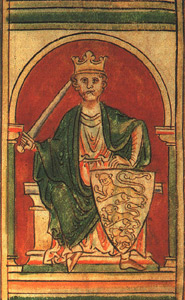Coat of arms of england
| Coat of arms of england | |
|---|---|

|
|
| Details | |
| Introduced | 1198 |
| Heraldic shield | Three golden, striding, blue armored and tongued, gazing lions on a red background |
The coat of arms of England contains three gold lions on a red background. Since it is a question of lions striding with their gaze towards the beholder, in the language of heraldry they are "leopards", see leopard ( heraldic animal) . In general, the three heraldic animals are usually referred to as "lions" (English Three Lions ).
Presumably the coat of arms of England derives from the coat of arms of Normandy . In the version with three lions, sometimes together with the French lilies , it was used by the English kings until the personal union of England and Scotland in 1603. It then became part of a combination with the Scottish and Irish coats of arms that, after numerous changes, still forms the coat of arms of the United Kingdom today.
The coat of arms of England is one of the national symbols of the country. For example, some national sports federations use modified forms as their own coat of arms.
history
After the Norman conquest of England in 1066 and the ensuing personal union between England and Normandy , the coat of arms of the Norman dynasty, two golden lions on a red background, was also used in England. A specifically English coat of arms, consisting of a golden soaring lion, appeared for the first time under Henry II .
The three lions were originally the personal coat of arms of Heinrich's son Richard , known as the Lionheart, adopted after his accession to the throne. Why three lions were suddenly used is unclear: According to tradition, the third lion came either from Henry's English coat of arms or from the coat of arms of Aquitaine and was intended to express the connection of the respective territories with Normandy, represented by the two remaining lions. It is possible that the number of lions at that time - heraldry was still young - had not yet been determined.
To the claim of Edward III. To symbolize the French throne, the French lilies were added in 1340. Their number was reduced to three in 1406 in order to adapt the representation to the modern French coat of arms. The lilies were still used together with the lions in the later, all-British coats of arms and did not cease to exist until 1801 when the coat of arms fields were redistributed as a result of the union with Ireland .
Historical development of the coat of arms
| coat of arms | Remarks | Period |
|---|---|---|
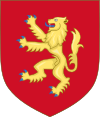
|
Royal coat of arms of Henry II. | 1154-1189 |
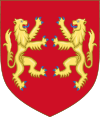
|
Older coat of arms of Richard I. | 1189-1198 |

|
Younger coat of arms Richard I. | 1198-1340 |

|
Coat of arms first used by Edward III. to assert his claim to the French throne. | 1340-1395 |
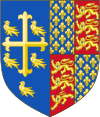
|
The coat of arms of Richard II included the old coat of arms of Edward the Confessor . | 1395-1399 |
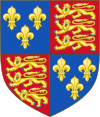
|
The English coat of arms was adapted to the use of the coat of arms of France and now shows the three French lilies. It was used with interruptions from 1399 and 1406 to 1603. | 1399-1422 |

|
King Henry VI. increased the claim to France. | 1422-1461 |

|
King Edward IV restored the previous coat of arms. | 1461-1470 |

|
King Henry VI. restored his coat of arms version when he was reinstated. | 1470-1471 |

|
King Edward IV finally restored the previous state. | 1471-1554 |
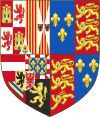
|
The coat of arms of England combined with the coat of arms of Philip II of Spain, as it was sometimes used by Maria I. | 1554-1558 |

|
Queen Elizabeth I restored Edward IV's coat of arms, which her father Henry VIII had also used. | 1558-1603 |
| With the unification of the Crowns of England and Scotland, the coat of arms of England becomes part of the coat of arms of the United Kingdom. | 1603-1649 | |

|
Commonwealth of England coat of arms . | 1649-1660 |

|
With the restoration of the monarchy in 1660, the English coat of arms again became part of the coat of arms of the United Kingdom. Its current shield shows the coat of arms of England in the first and fourth images. | 1660 - today |
Todays use
Use in sports

Similar to the earlier royal flag of Scotland , which also shows a coat of arms, flags with three golden lions on a red background are used unofficially instead of the actual flag of England at international matches .
Examples of non-governmental modified uses are the England and Wales Cricket Board and the English Football Association . Both use three blue lions on a white background in their club crests. The Football Association's crest also features Tudor roses , another symbol of England.
Coats of arms and flags of other territories

Even today, the coats of arms of England (in the original version) and Normandy are sometimes used almost unchanged, though not by sovereign states. For example, Normandy today uses a coat of arms and a flag with two lions (unofficially three are also used).
Some of the Channel Islands have red and gold lion crests: Guernsey and Jersey with three, Sark with two lions.
Modified versions with a lion (selection)
Some English colonies had (or even after their independence) only had one English lion in their coat of arms.
Likewise some Canadian provinces:
New Brunswick
(flag, also in coat of arms)Prince Edward Island
(flag, also in coat of arms)
See also
- Duchy of Lancaster (flag and coat of arms)
- Three Lions (anthem of the English national team for the 1996 European Football Championship in England)
